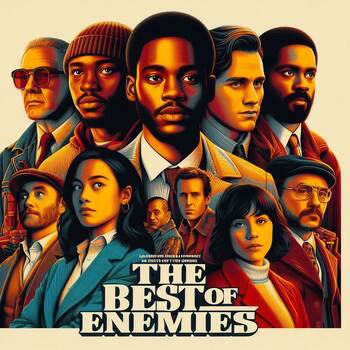The Best of Enemies (2019) Movie Viewing Guide: Summary/Vocabulary/Questions/KEY
- Word Document File
Description
Using "The Best of Enemies" (2019) in a history class offers a compelling opportunity to explore themes of racial tension, civil rights struggles, and community activism in American history. Here's a rationale for its use:
Civil Rights Movement: The film is set in the context of the civil rights movement in Durham, North Carolina, during the 1970s. It provides a nuanced portrayal of the challenges faced by African Americans in their fight for equality and the resistance they encountered from white supremacist groups and individuals.
Integration and Desegregation: "The Best of Enemies" delves into the theme of school integration and the struggle to desegregate public schools. By examining historical events such as the court-ordered busing of students to achieve racial balance, students can gain insight into the complexities of desegregation efforts and their impact on communities.
Historical Figures: The film features real-life historical figures, including civil rights activist Ann Atwater and Ku Klux Klan leader C.P. Ellis. Exploring the backgrounds, motivations, and interactions of these individuals provides a humanizing lens through which students can understand the complexities of race relations and social change.
Community Organizing and Activism: "The Best of Enemies" highlights the role of community organizing and grassroots activism in effecting social change. Students can analyze the strategies employed by civil rights activists and examine the power dynamics between different groups involved in the struggle for racial justice.
Intersectionality: The film explores intersecting identities and experiences, including race, class, and gender. By examining how these intersecting factors shape individuals' perspectives and experiences, students can deepen their understanding of the complexities of identity and inequality.
Reconciliation and Redemption: "The Best of Enemies" portrays themes of reconciliation and redemption, as unlikely allies find common ground and overcome their prejudices. Students can reflect on the possibilities and limitations of reconciliation in the context of historical and contemporary social conflicts.
Historical Context: Through discussions and analysis of the film's historical context, students can gain a deeper understanding of the broader historical forces that shaped the civil rights movement, including the legacy of slavery, Jim Crow laws, and resistance to racial progress.
Contemporary Relevance: "The Best of Enemies" prompts discussions about the ongoing struggle for racial justice and equality in the United States. By connecting historical events to contemporary issues such as systemic racism, students can explore the relevance of past struggles to present-day challenges.
Critical Thinking and Analysis: The film encourages critical thinking and analysis as students evaluate historical events, perspectives, and motivations portrayed in the movie. Through discussions and assignments, students can develop their skills in historical interpretation and analysis.
Overall, "The Best of Enemies" serves as a valuable educational tool for engaging students in meaningful discussions about race, history, and social justice in America. By examining the complexities of the civil rights movement through the lens of this historical drama, students can gain a deeper understanding of the ongoing struggle for equality and the importance of activism and solidarity in effecting social change.
The Best of Enemies (2019) INCLUDES:
Movie Viewing Guide: Summary/Vocabulary/Questions with KEY





